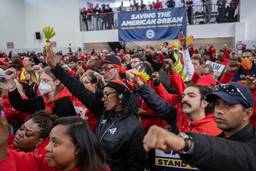If you drive a few blocks from Barack Obama’s Chicago home, you are plunged downward into a place where hope is a mirage.
It is a world of few good breaks and few good jobs.
This sprawling area on Chicago’s South Side has the nation’s second-highest unemployment rate. It was 23.2 percent in 2008. If you keep going west, then you hit Austin, the community with the nation’s seventh highest unemployment rate last year.
Lou Ransom, editor of the Chicago Defender, Chicago’s historic black newspaper, wrote a powerful column the other day about meeting the jobless on the streets of South Side and West Side Chicago. He wrote:
No, these folks aren’t going to work. Nobody is going to hire them. They have no skills. They have a poor work history. They have drug problems or health problems or just 99 other problems. Some of them have been out of work so long they can’t remember their last paycheck. So they do day work for a few dollars, something to get them through the day.
But Chicago doesn’t have the edge on jobless communities. Detroit does.
Figures put together recently by the Chicago Reporter from government statistics show that four of the nation’s 10 neighborhoods with the highest unemployment rates were located in Detroit.
The other cities containing communities with the leading jobless rates were Cleveland, St. Louis, Toledo and Atlanta.
Beyond their heart-breaking joblessness, what also links most of these communities is that most of their residents are black. The fact that black unemployment remains entrenched and enormous as compared to white society is nothing new.
But what’s different today is the lethal mixture of the nation’s economic collapse, with all the forces that have been wearing away at low income black workers: the disappearance of good-paying factory jobs, the shrinkage of factory jobs all together, and the creation of tiers of dead-end low-wage jobs with no benefits, no insurance, and no escape hatch from poverty.
The result is what we find in Chicago’s South Side and across Detroit – low-income black communities where joblessness has hardened and where the poor stand day after day with their faces stand pressed up against invisible walls that separate them from everyone else who has a foot up the economic ladder: black and white and yellow and brown.
What do we do?
We don’t kickstart the old poverty programs because times have changed. Today, the jobless need skills before jobs. Skills for jobs in the cities and not in far distant suburbs that they cannot reach. They need these skills in school while they are growing up in neighborhoods where jobs are a fantasy.
They need support for their families so they can get the training and the skills. And their families need income support so they do not fall apart when their luck runs out. These people need someone to pay their medical bills when they get hurt on the job, if they have one, or when they simply collapse because of all that has put them down.
In one way or another, the Obama administration has been talking about these kinds of solutions, though you can hardly hear the talk amid all the hollering about so much else.
But if we don’t pay attention now and raise the talk to a higher level, these street corners — not far from where the Obamas live — are going to overflow even more with the people Lou Ransom saw the other day. And hope isn’t going to be the song they will be singing.
A former labor writer for the Chicago Tribune, Stephen Franklin is a Pulitzer Prize finalist and an adjunct professor at the University of Illinois Urbana-Champaign School of Labor and Employment Relations.







